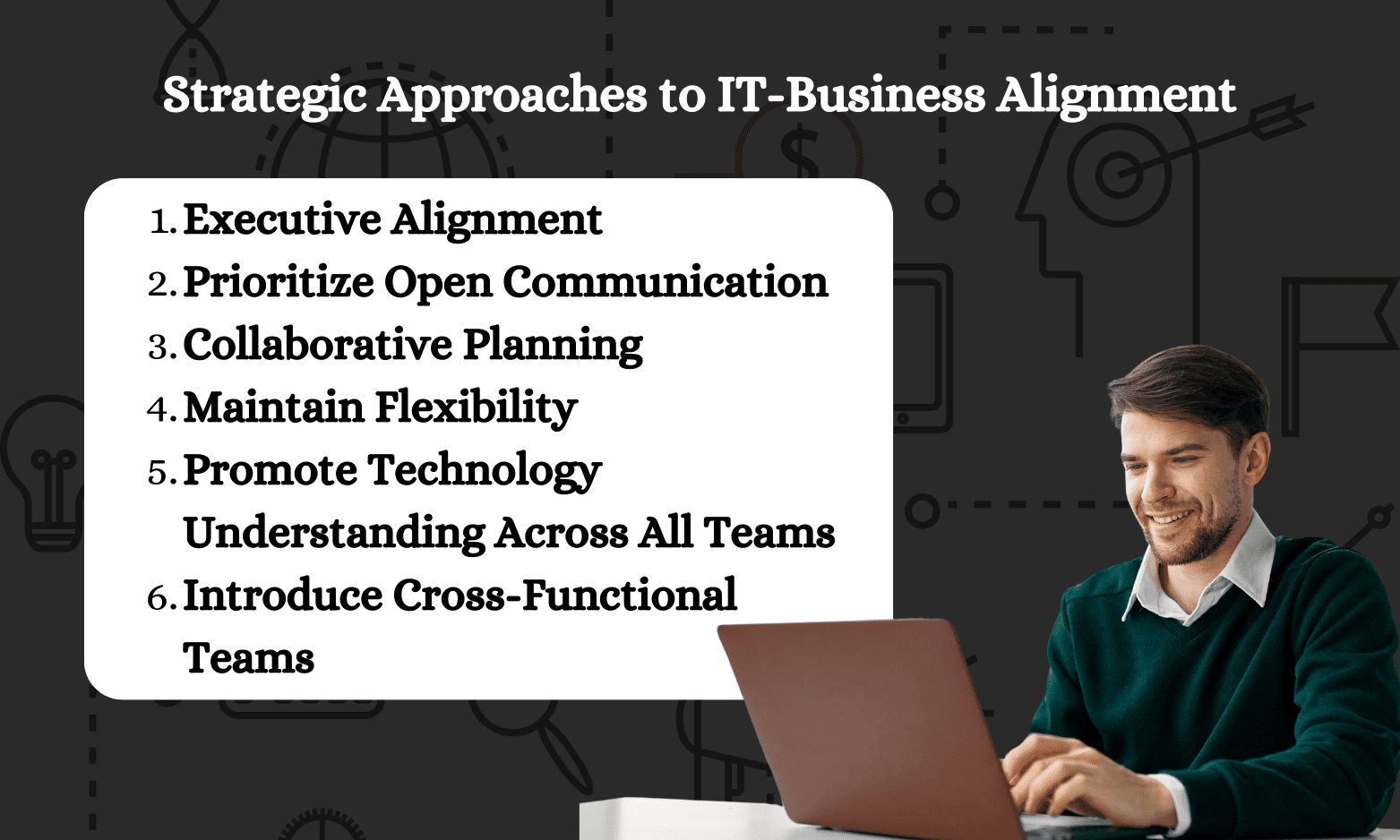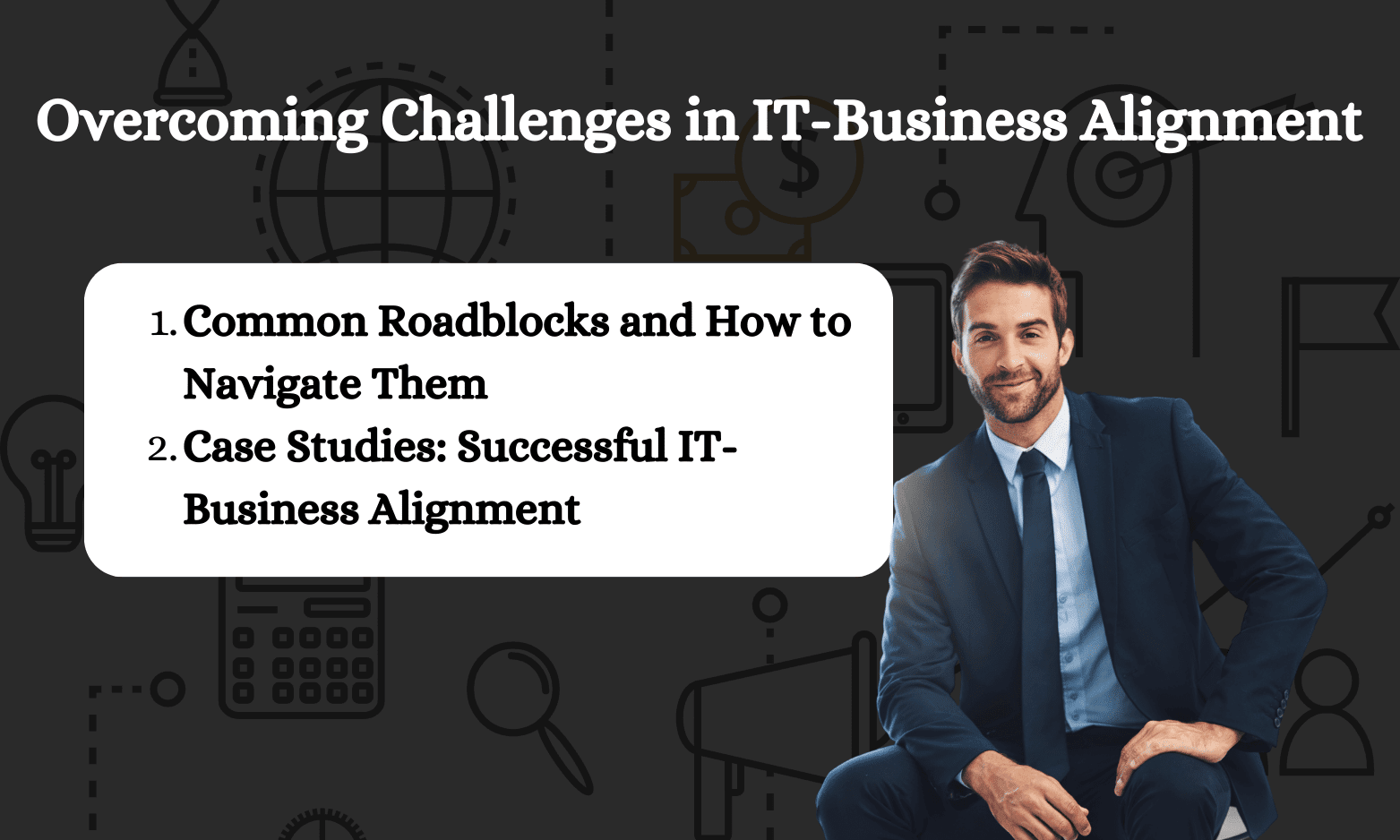
Synchronizing for Success: IT and Business Alignment
In a world of constant and accelerating technological advancement, businesses can no longer afford to separate their Information Technology (IT) departments from their broader business strategies. For any modern operation to reach its full potential, there must be a harmonious relationship between technology and enterprise objectives. This process is known as IT-business alignment. Are you interested? Let’s explore this crucial alliance together.


Introduction to IT-Business Alignment
Navigating technical terms may initially seem overwhelming, so let’s begin by defining IT-business alignment. It refers to synchronizing a company’s business strategy with its technological investments. In other words, it’s about ensuring that your tech department is in harmony with your overall corporate direction rather than operating independently.
Managed IT services should aim to deliver value by embedding digital tools into every aspect of your business journey rather than just providing functional support or fixing technical glitches occasionally. This involves upgrading systems, breaking down data silos, and leveraging technology to drive growth toward your strategic objectives.
MuleSoft’s report states, “87% of IT and business leaders feel their alignment has improved over the past year.” This trend reflects how embracing IT-business alignment is a cornerstone for adding sustainable value using fewer resources while enhancing efficiency and customer satisfaction.
The rise of dynamic business environments fueled by a fast-paced digital revolution elevates the importance of alignment. With customers’ preferences shifting more rapidly than ever, an aligned business can pivot quicker, adapt effectively, and make informed decisions diligently.
Robust IT-business alignment helps companies navigate market changes while remaining competitive in today’s commercial landscape.

Strategic Approaches to IT-Business Alignment
Modern organizations no longer view aligning IT and business strategy as a desirable goal but a necessity. This section provides insights to help map out the most effective strategies for achieving successful IT-business alignment.
Key Strategies for Aligning IT with Business Objectives
- Executive Alignment: Establishing a shared vision between IT and business leaders is essential. This alignment ensures that both parties are working towards common goals, setting the stage for effective collaboration and strategic success.
- Prioritize Open Communication: Spirited and proactive communication between the business units and the IT department is vital. This enables both parties to thoroughly understand each other’s objectives, workflows, challenges, and achievements.
- Collaborative Planning: The process of forming strategies should involve substantial stakeholders from both sides – the tech experts and the decision-makers from business-centric operations.
- Maintain Flexibility: As technology evolves rapidly, flexibility allows businesses to adapt more effectively without causing significant disruptions.
- Promoting Technology Understanding Across All Teams: Ensuring all teams have a basic understanding of the underlying technology can bridge gaps in knowledge that might hinder alignment.
- Introducing Cross-functional Teams: By incorporating members from different functional areas into project teams, you can facilitate better understanding and collaboration, leading to higher levels of innovation.
According to HDI’s report, organizations that align their business strategies with technological advancements are more likely to invest in AI, predictive analytics, service automation, and virtual agents in the next 12 months. This highlights the importance of forward-thinking planning that aligns with broader strategies in achieving success.
Role of Leadership in Facilitating Alignment
Leaders play a crucial role in facilitating the alignment of information technology and business objectives. They are not just influencers but also orchestrators who contribute significantly to this alignment in various ways:
- Visionary Leadership: Leaders should clearly understand how technology can benefit business strategy. They should create an environment where innovation thrives while remaining aligned with the organization’s core objectives.
- Alignment Advocates: Effective leaders act as ambassadors for IT-business alignment. They are crucial in promoting its understanding and importance throughout their organizations.
- Bridge Builders: Leaders are bridge-builders who connect the organization’s technical aspects and business-centric operations. They’re adept at translating technical jargon into terms that non-technical teams can understand, thus enhancing organizational harmony.
- Initiators of Change Management: With 41 percent of companies having a dedicated Digital Transformation team, it is becoming evident that change is ubiquitous and constant. Leaders can help ease this disruption by adequately preparing their teams for the inevitability of technological changes – thereby promoting efficient adaptation.
In essence, leadership is essential in aligning IT strategies with business goals to seamlessly integrate technology and deliver maximum value.

Overcoming Challenges in IT-Business Alignment
Aligning IT and business strategies is a complex task that poses several challenges. Despite the importance of synchronizing these two essential components, various factors can inhibit this process, creating unforeseen roadblocks. In this context, it is crucial to identify and navigate these challenges successfully. Let’s explore some common issues and strategies to overcome them.
Common Roadblocks and How to Navigate Them
A major hurdle in aligning IT and business strategy is the lack of communication and understanding between IT professionals and other business units. According to the Axelos IT Service Management Benchmarking Report, only 41% of IT professionals believe there is a clear alignment between their current goals and the overall direction of the business, even though 70% claim to understand their organization’s strategy.
To combat this issue:
- Promote open communication among all units – Continuous dialogue encourages understanding and joint ventures on projects.
- Foster education and training. Educate your team members about corporate strategy, which will help them relate their roles to larger objectives.
- Establish well-informed leadership. Leaders who deeply understand both fields can align IT strategies with business objectives.
One of the major challenges companies face is the rapidly changing technology trends, which often make it difficult for them to keep pace. This, in turn, leads to the development of fragmented systems that cannot support companywide initiatives. To address this issue, companies need to implement the following strategies:
- Regular update cycles: Technological updates must be consistent while considering compatibility among different systems within the organization.
- Flexible strategic models: Adopting flexible strategic models allows companies to adapt quickly whenever necessary without disrupting established workflow patterns.
Case Studies: Successful IT-Business Alignment
Procter & Gamble (P&G) demonstrated success in overcoming these concerns. P&G notably improved its bottom line when it realigned its worldwide operations with its key strategic move towards a consumer-centric business model. The company used technology to standardize and improve its numerous processes, leading to significant savings and better product launches.
Another success story comes from the retail sector – Walmart’s clever integration of IT into its inventory management and supply chain business model has been a key driver in its phenomenal growth. By employing sophisticated data analytics tools, Walmart ensured quick response times to market changes – an example of perfect harmony achieved through aligning IT with business strategies.
Overcoming challenges tied to IT and business strategy alignment isn’t easy. However, with strategic foresight and proper execution, as shown by these examples – it is well within reach.

Measuring the Impact of IT-Business Alignment
Measurement is crucial for successful alignment between IT and business. Evaluating harmony between IT and business goals enables organizations to track progress, identify opportunities for correction, and make data-driven decisions.
Metrics and KPIs for Assessing Alignment Success
An organization can measure the effectiveness of its IT-business alignment strategy by tracking several valuable metrics and Key Performance Indicators (KPIs). These metrics help in quantitatively assessing the success or bottlenecks in the operational processes and provide valuable insights for process improvement. Here are some of the recommended metrics to consider:
- Business Value Realization: This metric measures whether the IT initiatives deliver substantial business value.
- IT Spending as Percentage of Revenue: This is a simple yet insightful way to monitor if the company’s investment in IT aligns with its expected revenue growth.
- Effective Use of Resources: It quantifies how effectively physical and human resources are managed within an organization.
- User Satisfaction Score: These scores illustrate how well end-users perceive the new changes brought by IT strategies.
- Delivery Operations Efficiency: This metric examines how efficiently the internal stakeholders or customers have embraced new solutions.
Continuous Improvement and Adaptation
A crucial aspect of evaluating the impact of an organization’s actions is to continually strive for improvement and adaptation. Achieving perfect harmony between business strategy and IT policies is not always straightforward or seamless, and there may be roadblocks and diversions along the way.
However, there is no cause for concern! Recognizing that success depends on being able to adapt quickly is essential in overcoming these obstacles. Organizations should regularly review their strategies and make adjustments if their results do not meet their expectations.
By embracing a culture of consistent improvement and being able to respond to changes in circumstances, organizations can create more opportunities for robust growth. Remember that the goal is not just to align IT strategy with business strategy and move forward steadily. Organizations can continuously improve their processes by monitoring progress, which helps them to effectively respond to challenges or shifting priorities. This approach helps successful organizations turn potential obstacles into stepping stones for significant achievements.

Future Trends in IT and Business Synchronization
The technology industry is constantly evolving, which means that to maintain a strategic alignment between IT and business, companies need to be adaptable and forward-thinking. Looking toward the future of technology, it is clear that a few key trends will significantly impact how businesses synchronize their IT and business strategies moving forward.
Emerging Technologies Shaping IT-Business Alignment
Among these emerging trends poised to shape the future of IT-business alignment, prominent ones include machine learning (ML), artificial intelligence (AI), and big data analytics – powerful tools promising transformative potential across diverse industries.
- Machine Learning (ML) capabilities can introduce automation and efficiency into traditionally time-consuming processes. By utilizing ML’s pattern recognition and cognitive capabilities, organizations can make informed decisions and gain insights that can lead to intelligent business strategies. According to ManageEngine, IT service desks using machine learning-based technologies can free up to 30% of their support capacity.
- Artificial Intelligence (AI) applications take automation one step further with predictive analysis, real-time responses, and personalization mandates. AI can help organizations meet customer expectations while increasing operational productivity.
- Big Data Analytics can be deployed to analyze large volumes of data, enabling organizations to gain unprecedented granularity in understanding market dynamics. This can help them align strategically with evolving needs efficiently.
Preparing for the Future of IT and Business Integration
While embracing these emerging technological assets is critical, preparation for a successful transition requires more than mere adoption.
A few guiding principles can help companies to approach their work more efficiently:
- Shifting towards Agile Methodologies: Adopting agile models like DevOps or Scrum promotes department collaboration and minimizes discrepancies between IT strategy execution and overall business objectives.
- Investing in Upskilling: Facilitating ongoing training programs to keep the workforce apprised of evolving technology trends is crucial. Encouraging a culture of proactive learning helps ensure seamless navigation through change.
- Implementing Robust Cybersecurity Measures: As our reliance on digital tools increases, so does our susceptibility to cyber threats. Therefore, it is crucial to ensure that robust cybersecurity strategies are incorporated into the core foundation of IT-Business alignment.
As businesses explore new and exciting opportunities in the future, it is crucial to balance innovation and established best practices. Striking this balance will lead to successful synchronization and help companies thrive in the rapidly evolving digital landscape.
Need Some IT Support?
Conclusion
In conclusion, IT-business alignment is a critical process that enables businesses to leverage technological advancements to achieve their goals effectively. Organizations can achieve successful IT-business alignment by prioritizing open communication, collaborative planning, flexibility, promoting technology understanding across all units, and introducing cross-functional teams. Also, visionary leadership, alignment advocates, bridge builders, and initiators of change management play a crucial role in facilitating this alignment. By embracing IT-business alignment, businesses can unlock their full potential, remain competitive, and achieve sustainable growth.
Class IV: Your Partner for Aligning Business and IT Strategy
Keeping up with the ever-evolving technology landscape can feel overwhelming as we enter a digitized economy. But with Class IV as your strategic partner, you can easily navigate these uncharted territories. Our expert services include visioning, road mapping, and aligning your IT strategy with your business goals. We understand that every business has unique demands and offer personalized approaches tailored to your specific requirements.
At Class IV, we take the time to understand your organization, its challenges, and its aspirations. With our help, you can envision where you want to take your business and craft detailed roadmaps demonstrating how technology can facilitate this trajectory. Above all, we ensure that every aspect of technology we adopt synergizes with your strategic business objectives.
Partnering with Class IV means that you’re not only surviving but primed for astounding success in this digitized economy. With us by your side, technology becomes more than just wires and code; it becomes a key driver behind your business’s success. So, let’s redefine what it means to be ‘in sync’ as we co-pilot your business into the future!

